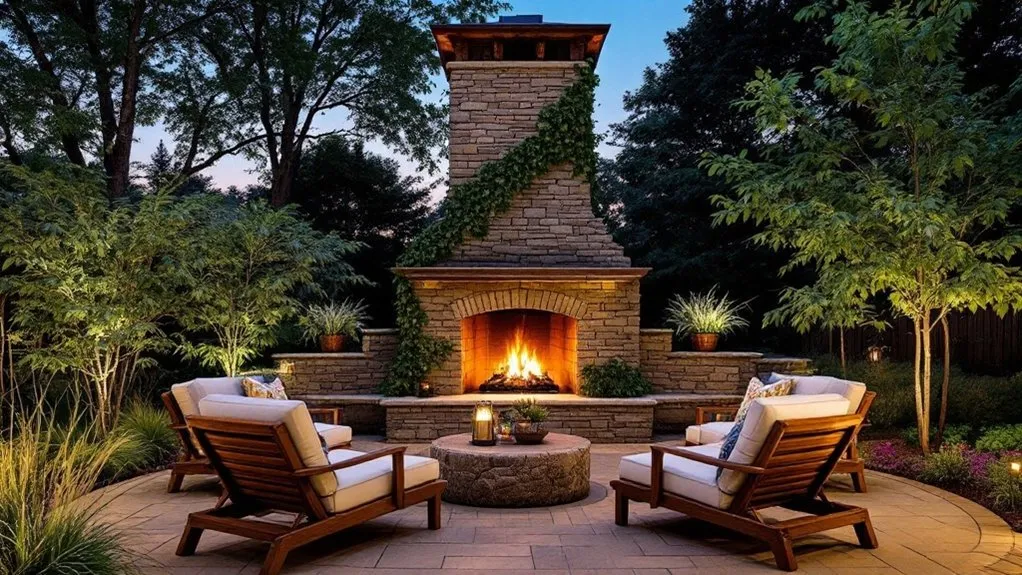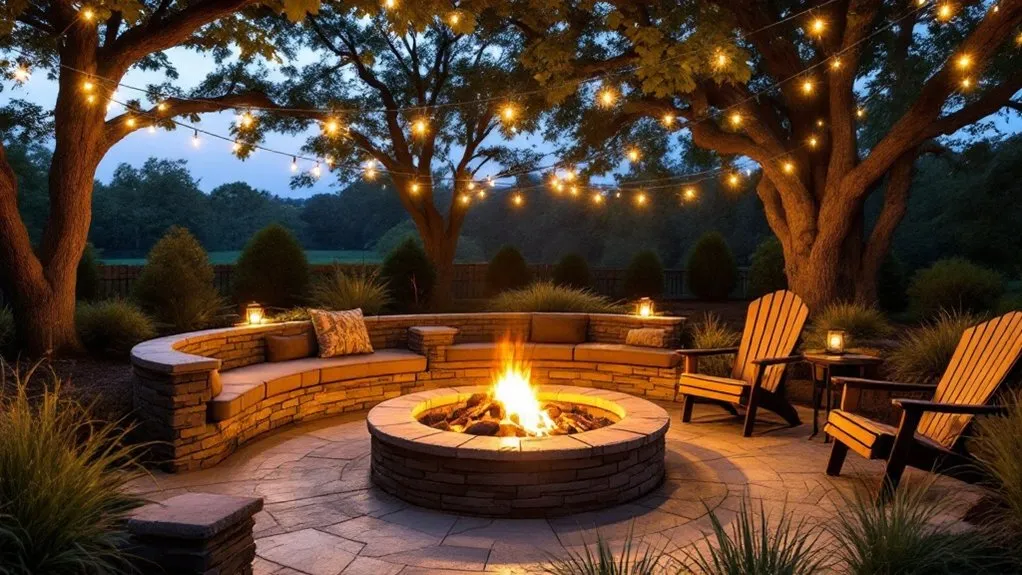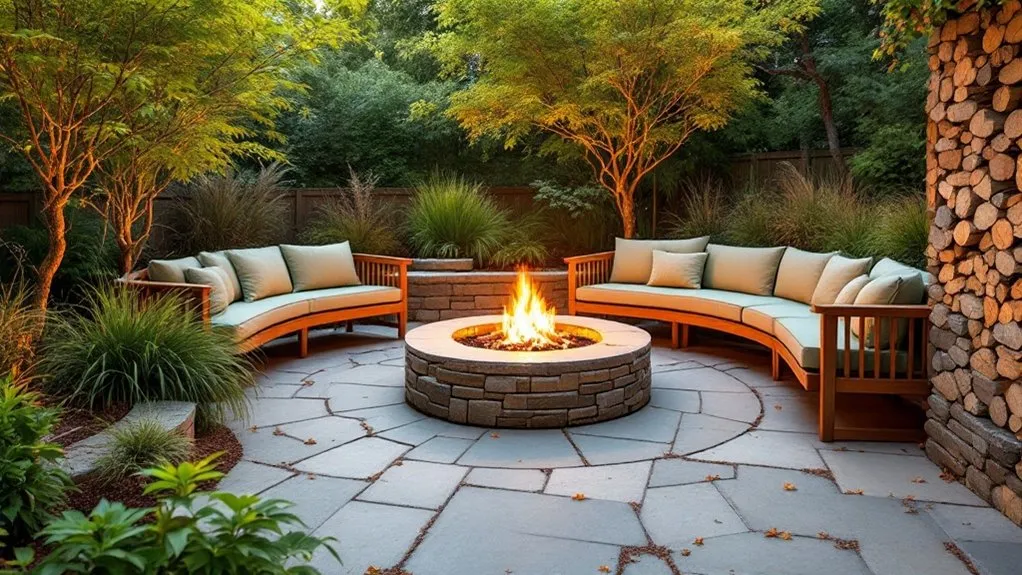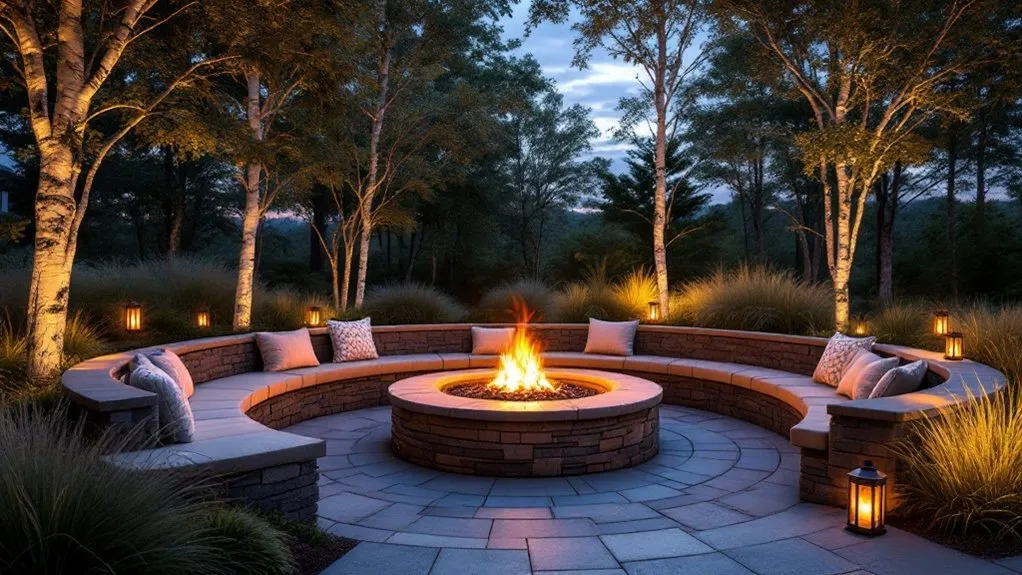Fire pits and outdoor fireplaces transform your landscape into a year-round outdoor retreat, offering aesthetic appeal and functional gathering spaces. You’ll create an intimate atmosphere with a fire pit’s 360-degree seating or make a bold architectural statement with a permanent fireplace. Position your chosen feature 10-20 feet from structures, surrounded by weather-resistant seating 8-15 feet from the flames. Proper material selection and strategic placement make your outdoor fire feature the cornerstone of countless relaxing evenings ahead.
Key Takeaways
- Fire features create intimate gathering spaces with 360-degree seating arrangements, fostering relaxed social interactions and meaningful conversations.
- Natural flames provide dynamic lighting that enhances garden textures and creates a soothing ambiance throughout evening gatherings.
- Strategic placement with comfortable seating zones, 8-15 feet from the fire, establishes cozy outdoor living spaces for year-round enjoyment.
- Fire elements serve as visual anchors in landscapes while extending outdoor entertainment possibilities beyond warm-weather months.
- Thoughtful material selection harmonizing with existing landscape elements creates a cohesive, tranquil atmosphere for outdoor relaxation.
Choosing Between Fire Pits and Outdoor Fireplaces: What’s Right for Your Space

When selecting between a fire pit and an outdoor fireplace, several key factors will determine which option best suits your landscape design.
Fire pit features offer 360-degree seating and create an intimate gathering space, ideal for larger groups and open areas. They’re typically more budget-friendly and can be portable.
Outdoor fireplaces, however, provide a striking focal point that enhances your outdoor aesthetics with architectural presence. They’re perfect for defining spaces and creating privacy screens.
Consider your available space, budget, intended use, and local regulations. Fireplaces need more square footage and permanent installation, while fire pits offer flexibility in placement and design options.
Design Styles and Materials That Complement Your Landscape
Modern outdoor fire features demand thoughtful material selection to harmonize with your existing landscape elements.
You’ll want to contemplate natural stone, cast concrete, or sleek metal finishes that align with your home’s architectural style. Opt for minimalist designs using polished concrete or stainless steel for contemporary landscapes. Traditional settings benefit from stacked stone or rustic brick configurations.
Your design inspirations should flow from the surrounding environment.
Match your fire feature’s materials to hardscape elements like retaining walls or pavers. Reflect on how textures and colors will weather over time, ensuring your material selection creates a cohesive outdoor living space that ages gracefully.
Creating the Perfect Gathering Zone Around Your Fire Feature

Designing a comfortable gathering zone requires strategically placing seating arrangements 8-15 feet from your fire feature.
Consider a circular or semicircular gathering layout that encourages conversation while maintaining clear sight lines to the flames. Incorporate built-in benches, weatherproof sofas, or Adirondack chairs arranged in conversational clusters.
Your seating arrangement should include both primary and secondary options—position permanent seating elements to block prevailing winds and include moveable pieces for flexibility.
Add side tables between chairs for drinks and plates. Create pathways that allow easy movement between the seating area and your home’s entry points.
Safety Considerations and Local Regulations for Outdoor Fire Features
Before installing any outdoor fire feature, you must check your local building codes and obtain the necessary permits to guarantee compliance with safety regulations.
Your fire pit or fireplace must maintain specific clearances from structures, typically 10-20 feet, depending on your jurisdiction, and should be positioned away from overhead tree branches.
A non-combustible surface beneath and around your fire feature and appropriate safety barriers or screens will protect your property and guests from potential hazards.
Permit and Code Requirements
When planning an outdoor fire feature, complying with local building codes and obtaining necessary permits is critical for safety and legal compliance.
You must research your area’s local ordinances and secure proper building permits before construction begins.
- Check zoning restrictions that dictate fire features’ placement, size, and fuel type requirements.
- Submit detailed plans showing setbacks from structures, property lines, and combustible materials.
- Schedule required inspections during construction phases, particularly for gas line installations.
Understanding and following these requirements helps guarantee your fire feature meets safety standards while avoiding potential fines or mandatory modifications.
Contact your local building department for specific guidelines in your jurisdiction.
Distance From Structures Required
Proper spacing between outdoor fire features and existing structures is a critical safety requirement for any landscape design.
Depending on local regulations, you’ll need to maintain a minimum clearance of 10-20 feet from your home’s exterior walls. For built-in fireplaces, guarantee at least 15 feet of space from tree branches and overhanging vegetation.
Portable fire pits require a 10-foot clearance from structures and combustible materials.
Consider fire safety when positioning your feature near wooden decks, fences, or outdoor furniture.
Always verify specific distance requirements with your local building department, as setback rules vary considerably between jurisdictions.
Protective Surface and Barriers
Installing protective surfaces and barriers around fire features represents a fundamental safety requirement in landscape design.
You must incorporate non-combustible materials that create a secure perimeter while maintaining aesthetic appeal. Fire pit materials like concrete pavers, natural stone, or heat-resistant tiles form an essential protective foundation.
- Install a minimum 24-inch non-combustible border around your fire feature using gravel, crushed stone, or masonry.
- When elevation changes exist, implement safety barriers such as tempered glass panels or metal railings.
- Use fire-resistant materials to position permanent seating at least 30 inches from the flame area.
Year-Round Benefits of Adding a Fire Element to Your Yard

Adding a fire element to your yard transforms it into a versatile outdoor living space that you’ll enjoy far beyond the warm summer months.
Your patio or deck becomes a cozy gathering destination even during chilly spring evenings or crisp autumn nights, as the radiant heat creates a comfortable microclimate for entertaining and relaxation.
The natural glow from your fire feature provides essential ambient lighting for outdoor activities while establishing an inviting focal point that anchors your landscape design throughout all seasons.
Extended Outdoor Living Season
When homeowners incorporate a fire element into their landscape design, they transform their outdoor living space into a year-round destination.
Your outdoor heating solution extends usability beyond summer, creating opportunities for seasonal gatherings throughout spring, fall, and even winter.
- Temperature management allows you to enjoy crisp autumn evenings without retreating indoors.
- Early spring entertaining becomes possible weeks before warm weather arrives.
- Winter socializing transforms your yard into a cozy retreat, even during the coldest months.
You’ll naturally gravitate toward your outdoor space more frequently, maximizing your landscape investment and expanding your home’s functional living area throughout the year.
Cozy All-Weather Gathering Space
Through the thoughtful placement of a fire feature, your outdoor space transforms into an intimate gathering hub that draws people together naturally. Strategic arrangement of cozy seating and outdoor decor around your fire element creates distinct zones for conversation and relaxation.
| Season | Comfort Elements | Design Considerations |
|---|---|---|
| Spring | Wind barriers | Adjustable screens |
| Summer | Shade solutions | Moveable furniture |
| Fall | Heat reflection | Weather-resistant fabrics |
| Winter | Thermal mass | Protected fuel storage |
Your outdoor living area becomes a versatile retreat regardless of weather conditions, offering comfort through changing temperatures and seasonal shifts. The fire feature acts as both a functional centerpiece and a visual anchor.
Natural Evening Light Source
Fire elements serve as sophisticated lighting solutions that extend your outdoor living hours well into the evening. The warm glow creates layered ambient lighting that enhances your landscape’s architectural features while providing functional illumination for nighttime activities.
- Your fire pit’s natural flame creates a dynamic interplay of light and shadow, highlighting garden textures and pathways.
- The controlled blaze offers an adjustable evening ambiance, unlike static landscape lighting.
- You’ll achieve 360-degree illumination that radiates outward, softly lighting gathering spaces.
This natural light source complements existing landscape lighting while adding depth and dimension to your outdoor living space after sunset.
Maintenance Tips to Keep Your Fire Feature Looking Beautiful
Proper maintenance of your outdoor fire feature guarantees its longevity and preserves its visual appeal throughout the seasons.
Schedule regular fire feature cleaning after each use by removing ash, debris, and soot buildup. Inspect burners and gas lines monthly for blockages or wear for gas-powered units.
Implement seasonal maintenance by covering your fire feature during harsh weather and thoroughly inspecting mortar joints, stone surfaces, and metal components each spring and fall.
Apply appropriate sealants to protect masonry, and immediately address any cracks or damage—clear drainage to prevent water accumulation, which can deteriorate materials over time.
Smart Placement Strategies for Maximum Impact and Comfort

Beyond maintaining your fire feature’s condition, strategic placement shapes its functionality and aesthetic impact in your outdoor space.
Smart fire feature placement requires careful consideration of comfort enhancements and spatial dynamics.
- Position your fire feature at least 10 feet from structures and overhanging trees while creating a natural focal point that draws the eye through your landscape design.
- Consider prevailing winds to minimize smoke disruption to seating areas when selecting your location.
- Design a comfortable seating radius of 3-7 feet around the feature, accounting for heat distribution and conversation flow.
Remember to balance safety requirements with design aesthetics for ideal results.
Frequently Asked Questions
How Many People Can Comfortably Fit Around Different Sizes of Fire Pits?
Your fire pit capacity depends directly on its diameter.
You’ll comfortably seat 2-4 people around a 30-inch pit, 4-6 around a 36-inch model, and 6-8 people with a 48-inch diameter.
For ideal seating arrangements, allow 24 inches of space per person.
Consider circular seating layouts for intimate gatherings or curved bench configurations for larger groups.
Remember to position chairs 24-30 inches from the pit’s edge for safety and comfort.
Can I Install a Fire Feature Myself, or Must I Hire Professionals?
While you can tackle basic DIY installation of portable fire pits and prefabricated units, permanent structures like built-in fireplaces require professional expertise.
Safety considerations are essential, including proper ventilation, distance from structures, and local building codes.
If you’re confident with basic construction, you can install a simple fire pit using premade blocks. Still, anything involving gas lines or extensive masonry work should be left to certified professionals.
What’s the Average Cost Difference Between Gas and Wood-Burning Fire Features?
Gas fire features typically cost $2,000-4,000 more upfront than wood-burning options, primarily due to installation costs for gas lines and safety components.
However, gas advantages include lower long-term maintenance differences, with virtually no cleanup required.
While wood efficiency is lower and requires regular fuel purchases, you’ll save on initial setup.
Your aesthetic choices might influence the decision – gas offers modern precision, while wood provides traditional charm and authentic crackling.
How Close Can Trees and Plants Be to Fire Features?
For ideal tree safety, you must maintain a minimum clearance of 10-15 feet between any fire feature and overhead branches.
When planning plant selection, keep all vegetation at least 5 feet from the fire pit or fireplace perimeter.
You’ll want to choose fire-resistant plants like succulents or stonecrop for nearby landscaping.
Consider prevailing winds when positioning your fire feature to prevent smoke and embers from damaging surrounding greenery.
Do Outdoor Fire Features Affect Home Insurance Rates?
Yes, outdoor fire features can impact your home insurance rates.
You’ll need to review your insurance policy carefully, as some providers may increase premiums due to added risk factors.
To minimize rate increases, demonstrate your fire feature safety measures: proper installation by certified contractors, adherence to local building codes, and presence of safety equipment.
Some insurers might require specific documentation or safety certifications before providing coverage for your outdoor fire installation.

